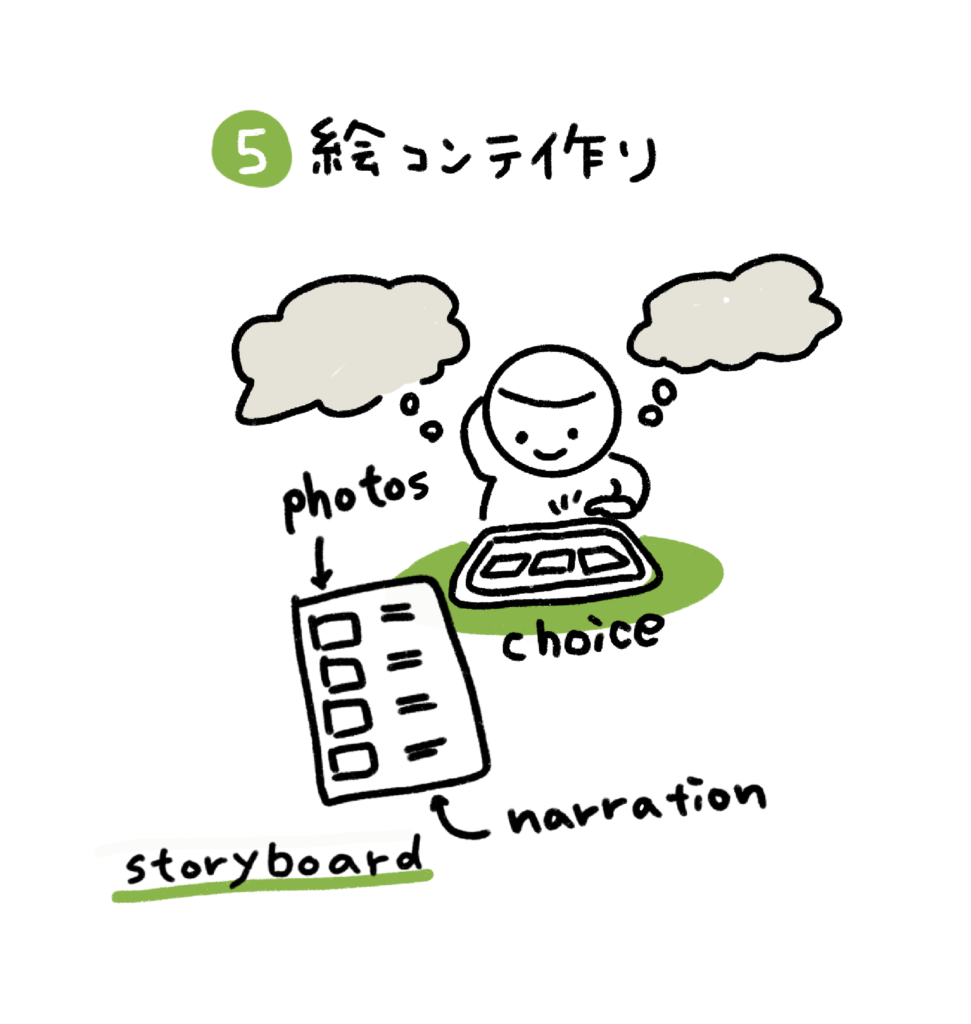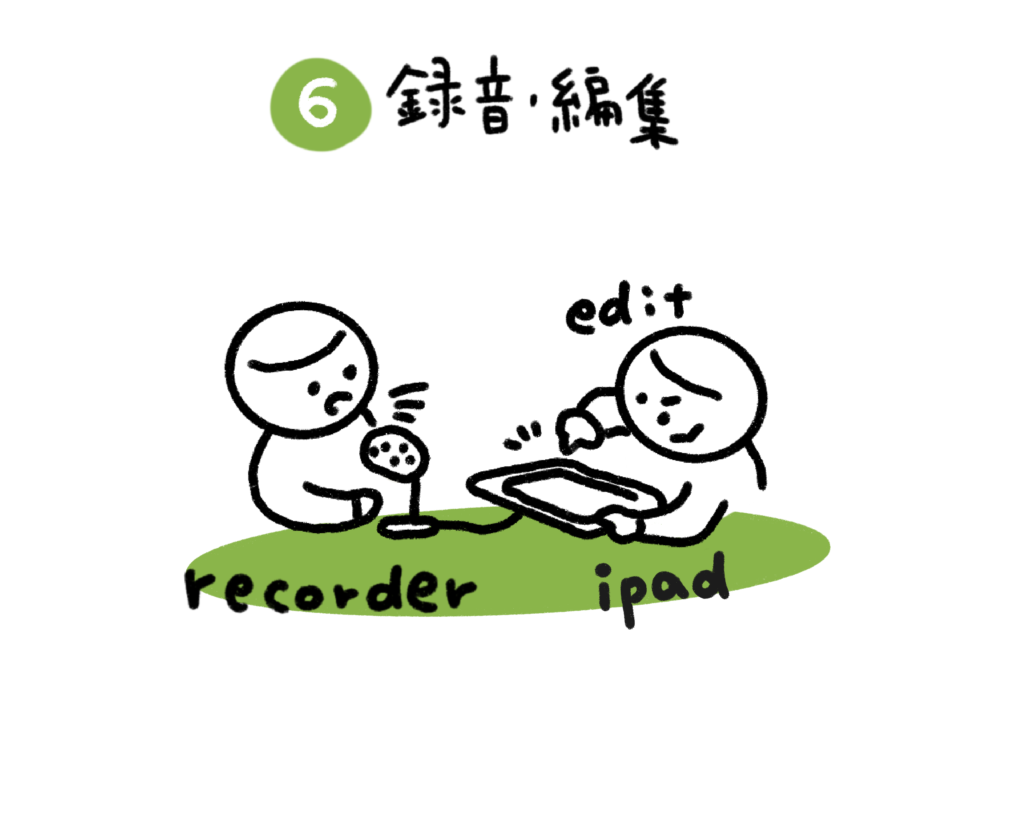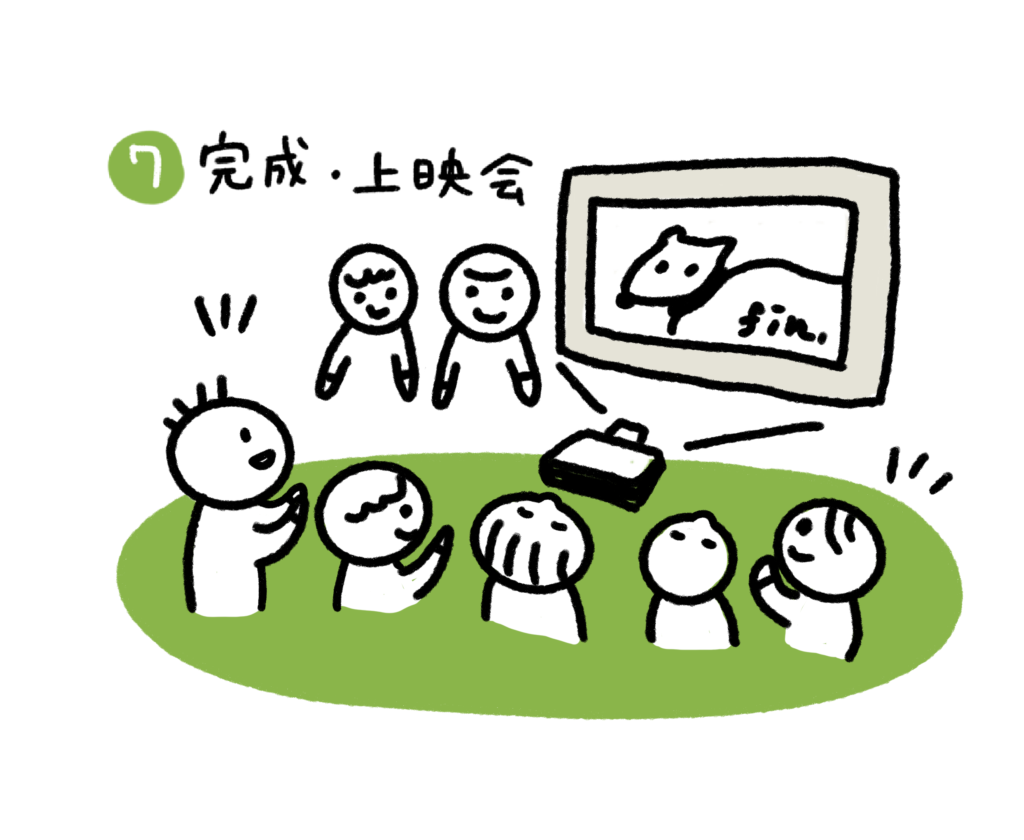WORKSHOP
ワークショップの手順 / Workshop Procedures
メディアコンテでは、参加者やその目的に応じてその都度プログラムを考案していますが、ここでは最も基本的な手順をご紹介します。
Setting aside the Western assumption that everyone has a story to tell, we tried to design workshop programs enabling ordinary people to tell stories on themes such as their everyday thoughts and dissatisfactions. As an attempt to seek out a model of digital storytelling which fits Japanese society in light of these doubts, we have held three digital-storytelling workshops named “Media Conte” since 2008.

1.写真組み合わせストーリー(1組5分程度)
物語を作る練習として、最初に行われるワークショップです。
参加者とファシリテーターが2人1組になって、まったく関係のない2枚の写真をつなぐ物語を考えます。そして、それぞれの写真からイメージされるキーワードを、とにかくたくさん付箋に書き出し、それらを組み替えることで物語にしていきます。
※たとえば「餅」なら、「お雑煮」「お正月」「海苔」「おばあちゃん」「ふくらむ」「保存食」などの、直接的、間接的なイメージを付箋に一つずつ書き出し、物語化するときの手がかりに使っていきます。
1. Combining photographs into stories
In this game-like program, each participant choses a photograph from a diverse collection of photos of subjects such as frogs, rice cakes, and foxes, attaches the photo to a base card, and then pairs it with another participant’s to create a story linking their two motifs within the limited time available. While simply attempting to link the two photographs as-is would not be very successful, participants were able to identify and visualize the structural elements of potential stories by using sticky notes to write down the symbols, representations, and connotations that each photo brought to mind. They then are able to develop stories by combining and connecting these elements together. Through this game-like experience with the tasks of deconstructing representations and combining them together, participants generated a succession of unique, structured stories that surpassed expectations.Another intention of this program was to show the students that storytelling practice was a freewheeling activity in which, unlike their schoolwork, there were no right or wrong answers.

2. お題ぺたぺた(1人3分程度×2~3回)
ここから、参加者は実際に自分自身の物語を考えていきます。
まずは参加者とファシリテーター2~3名1組のグループを作り、「やっかいなこと」「私の宝物」「手」などのお題を渡します。参加者はそれぞれのお題に答え、他の参加者やファシリテーターは様々な質問を発表者に投げることで話を膨らませ、物語の「種」を引き出していきます。
※最初のお題から外れていって全く構いません。むしろ、さまざまな話を引き出し、そこからその人らしさ、その人が言いたいことの種をとにかくたくさん見つけ出します。
2. Discussion time
Starting with this program, each individual move forward to generating his or her story. First, five business card sized cards are prepared, each with a single question written on it. Subjects included “my treasure,” “annoyances,” and “my most important event.” Facilitators placed one of these cards in the middle of a sheet of white A3-sized paper and asked questions related to the subject on the card. Subjects such as experiences and thoughts spoken about in response to the questions, and ideas and images associated with them, were written on sticky notes and attached around the card to identify motifs and episodes that could serve as the seeds of a story. If an interesting topic came up during the discussion, the card in the center of the sheet of paper would be replaced with a new note recording the new and interesting episode or motif, for use in assembling a story.
2. お題ぺたぺた(1人3分程度×2~3回)
ここから、参加者は実際に自分自身の物語を考えていきます。
まずは参加者とファシリテーター2~3名1組のグループを作り、「やっかいなこと」「私の宝物」「手」などのお題を渡します。参加者はそれぞれのお題に答え、他の参加者やファシリテーターは様々な質問を発表者に投げることで話を膨らませ、物語の「種」を引き出していきます。
※最初のお題から外れていって全く構いません。むしろ、さまざまな話を引き出し、そこからその人らしさ、その人が言いたいことの種をとにかくたくさん見つけ出します。
2. Discussion time
Starting with this program, each individual move forward to generating his or her story. First, five business card sized cards are prepared, each with a single question written on it. Subjects included “my treasure,” “annoyances,” and “my most important event.” Facilitators placed one of these cards in the middle of a sheet of white A3-sized paper and asked questions related to the subject on the card. Subjects such as experiences and thoughts spoken about in response to the questions, and ideas and images associated with them, were written on sticky notes and attached around the card to identify motifs and episodes that could serve as the seeds of a story. If an interesting topic came up during the discussion, the card in the center of the sheet of paper would be replaced with a new note recording the new and interesting episode or motif, for use in assembling a story.


3. 5コマ紙しばい
お題ぺたぺたで書き込んだ付箋のなかから、物語の中心になりそうなものをいくつか選び出し、それらを大雑把に5つのシーンに並べていきます。そして、どのシーンにどのような写真をつけるかを考えながら、物語の流れを5枚の紙しばいで表現します。出来上がった紙しばいは全員の前で発表し、さらに面白い作品にするためにはどうすればいいか、みんなでアイディアを出し合ってディスカッションを行います。
※最初の「つかみ」と最後の「終わり方」、そして興味をひくタイトルがポイントです!
3. Storytelling with five picture cards
From the collected sticky notes with subjects such as expressed thoughts and experiences written on them, elements that appeared likely to serve as seeds for a story are selected and related notes are attached to five picture-storytelling cards, to create the outline of a story.After the picture story outlines are presented by facilitators and participants in pairs, all participants exchange feedback including questions, comments, and advice, thinking together about what kinds of photographic images would be effective to use in the stories, and thought about the kinds of photos to take and items to bring with them.

4.撮影・取材
物語の流れに沿って、必要な写真を撮り集めていきます。
4. Taking and Collecting images
4.撮影・取材
物語の流れに沿って、必要な写真を撮り集めていきます。
4. Taking and Collecting images


5.絵コンテ作り
撮り集めた写真を選別し並べながら、物語の絵コンテを作ります。
同時に、どのシーンにどのようなナレーションを充てるか考えながら、ナレーションの原稿も作ります。
※ナレーションはなるべく自分のことばで。ですます調、客観的なレポート調よりも、心の中でしゃべっているような話し方にしたほうが面白いです。
5.Storyboard production
If possible, photos taken and prepared are printed, attached by hand to picture-script cards, rough voiceover is written to the side as questions are asked about the photos taken, with the story structure being devised by their arranging and rearranging. Once a structure has been decided on, writing of the narration begins.Facilitators or participants load the photo data arranged onto their own tablets or smartphones and edit them using a suitable or familiar app.
※ We recommend that participants should speak in their colloquial way.

6.録音編集
パソコンにナレーションを録音し、さらに写真を並べて、2分程度の映像作品になるよう、編集していきます。
6.Recording voiceover and editing
Participants add photos and their own voiceover to their work, using their tablets or smartphones.
6.録音編集
パソコンにナレーションを録音し、さらに写真を並べて、2分程度の映像作品になるよう、編集していきます。
6.Recording voiceover and editing
Participants add photos and their own voiceover to their work, using their tablets or smartphones.


7.完成・上映会
できあがった作品はみんなで視聴し、感動を分かち合います。
7. Preview
Completed works are screened at community events and seminars. The participant and facilitator pairs introduce the works prior to the screening, and then they watch them together with community residents, visitors, and other participants on a big screen. In addition, in order to share these stories with local community members, the works are broadcast on the local cable television at a later date. On each station, special programs were carried together with documentaries on the process of producing the work.


